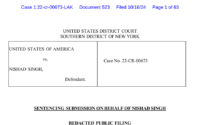A Pre-I.P.O. Gift to Company Executives: ‘11th-Hour Options Discounting’
Public companies must abide by strict rules when granting stock options to their top executives, including pricing them where the company’s shares are trading on the day they are granted and disclosing them swiftly.
Private companies planning to go public face some of the same requirements, but have more leeway in pricing their stock options — since there is no publicly traded price — and more time to disclose them.
That discrepancy has prompted dozens of private companies to give their top managers low-priced options in the weeks leading up to their initial public offering — when they can often accurately predict where their shares are likely to trade, but before public company regulations about options pricing kick in, according to a new research paper by Sven Riethmueller, a professor at Yale Law School.
“They just slide in these equity grants at the last minute,” said Mr. Riethmueller, referring to the options. He called the practice “11th-hour options discounting.”
In his paper, Mr. Riethmueller looked at 121 biotechnology companies heading toward an I.P.O. between 2017 and 2021. He found that 74 issued options to executives and employees in the 90 days before their public debut at an average discount of 48 percent of the I.P.O. price.
Zoom, Beyond Meat and Eventbrite were among companies that also granted cheap stock options to their top executives and employees before going public. Mr. Riethmueller pieced together his findings by combing through filings and obtaining nonpublic correspondence between the Securities and Exchange Commission and individual companies via the Freedom of Information Act.
Mr. Riethmueller found that by pricing options at the last minute, companies nearly guarantee that awardees will have a paper windfall on the first trading day. The little-known practice has become hugely popular with young companies that frequently use cheap stock options as a way to lure C-suite executives. Companies don’t often disclose the number of options given to individual executives until the night before trading day, once the I.P.O. price has been set.
Less than a month before its initial public offering, a small Boston-based biotech company called Galecto issued its top executives nearly one million stock options, each priced at $7.70, which it disclosed in a filing.
What Galecto didn’t disclose until after its I.P.O. price of $15 per share had been set based on investor interest was that more than half of those deeply discounted options went to the company’s chief executive. When Galecto went public on Oct. 28, 2020, the value of the chief executive’s options rose by $4 million.
By withholding information before the I.P.O. pricing, Galecto denied investors the chance to accurately evaluate whether or not to buy its shares at the $15 price. The information imbalance also meant that investors didn’t get to fully assess Galecto’s compensation expenses and whether the interests of its top executives aligned with theirs.
A Galecto spokeswoman, Sandya von der Weid, wrote in an email that the company couldn’t issue the options sooner because it had to wait for a private financing round to close before their valuation could be established. “These grants were recommended by an independent compensation consultant and approved by Galecto’s board,” she added.
Stock options, which grant the holder the right to periodically buy a company’s stock at a predetermined price over several years, are a popular component of the pay packages of senior executives.
Under rules established by the S.E.C., public companies can issue stock options only at market prices (or face draconian tax consequences) and must disclose them for top executives and other insiders within two days of granting them. By setting the so-called strike price of options at the market price, companies create incentives for executives to increase the value of the shares by the time the options vest; a higher stock price in general is good for all investors.
The rules were established after the options backdating scandal of the mid-2000s, when companies had a long time horizon within which to report such awards. In the late 1990s and early 2000s, more than 100 companies set the date of options issued to days when their shares were at their lowest; this backdating allowed executives to reap greater financial rewards.
The timing gave their executives instant paydays when the stocks rose, making them “in the money” immediately, at least on paper. The companies eventually became the subjects of lawsuits and huge fines levied by the S.E.C. Some executives were sentenced to prison.
The S.E.C. also requires robust disclosures from private companies about the stock options they grant to their top executives. However, unlike with public companies, private companies have to disclose such details only for each full financial year before going public. That reporting gap between filing their last financial report and conducting their I.P.O. is the sweet spot when many pre-I.P.O. companies hand out cheap options and disclose information selectively, Mr. Riethmueller found.
Zoom offered a discount of roughly 55 percent by offering options on Jan. 24, 2019, at $16.02 and then again on Feb. 28, 2019, at $16.72, according to his research. When it went public on April 17, 2019, it sold shares to investors at $36.
Beyond Meat issued options at $20 per share on April 3, 2019, and then went public at $25 on May 1, 2019; the 20 percent discount was less extreme.
Eventbrite issued options on July 24, 2018, and July 31, 2018, at $13.72 and then went public on Sept. 19, 2018, at $23 per share. Mr. Riethmueller estimated that, at the I.P.O. price, Eventbrite had offered its chief executive a $26.7 million potential windfall based on the option to buy 2.9 million shares.
Representatives of the three companies declined to comment.
An S.E.C. spokeswoman said executives who were granted options had to disclose them, including their strike price and quantity, before the first day of trading. She declined to comment further on Mr. Riethmueller’s findings.
Erik Lie, a finance professor at the University of Iowa who discovered the backdating of stock options, read Mr. Riethmueller’s paper recently. Mr. Lie said he saw parallels between options backdating then and the options discounting that Mr. Riethmueller unearthed. “To me, it’s a simple game — you’re getting the stock really cheap.”
In 2005, the S.E.C. changed the rules around disclosure and accounting of executive stock options in response to the Enron scandal, forcing companies to clearly mark stock options as part of overall compensation. After that, their use dropped.
Todd Gormley, a finance professor at Olin Business School at Washington University in St. Louis, questioned whether private companies would still issue these pre-I.P.O. options if they had to be disclosed more thoroughly to regulators and investors. “If it’s not easy for someone to figure out how much the person was paid, you behave differently when it’s more transparent.”
For private companies, the S.E.C. requires options to be priced based on calculations of an “expected market price,” since there is no public trading. Private companies typically keep the S.E.C. apprised confidentially of their executive compensation numbers in the lead-up to their I.P.O.
But Mr. Riethmueller said the regulator rarely challenged a company’s assumptions about how it had come up with the value of its stock or options, based on his review of confidential letters between the companies and the regulator. The S.E.C. acts “like an absentee landlord,” he said.
Companies try to set a low expected market price to make the discounted options appear less egregious to regulators, Mr. Riethmueller said.
One popular way they lower the valuation is by saying there’s a good chance they won’t go public even when they’re on the verge of their trading debut. In the confidential communication, companies explained their options pricing by using a valuation method that accounted for the potential price of their stock in an I.P.O., as well as the likelihood of their going public.
By including the probability of not going public, they arrived at a lower, so-called blended valuation of their target I.P.O. stock price.
Most firms estimate the likelihood of going public at around 60 percent — even when in many cases, these firms have already set a date to ring the bell at the New York Stock Exchange or Nasdaq within weeks or months. (Of the 121 companies Mr. Riethmueller looked at, only five stayed private.)
“Instead of preparing the company properly for the new public investors that are coming in, they’re taking advantage of them by doing inside deals at the expense of the new investors,” Mr. Riethmueller said.


